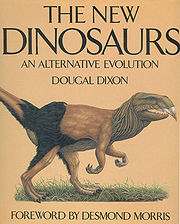
The New Dinosaurs: An Alternative Evolution
Encyclopedia

Geologist
A geologist is a scientist who studies the solid and liquid matter that constitutes the Earth as well as the processes and history that has shaped it. Geologists usually engage in studying geology. Geologists, studying more of an applied science than a theoretical one, must approach Geology using...
and paleontologist Dougal Dixon
Dougal Dixon
-Biography:Dixon studied geology and palaeontology at the University of St. Andrews and is best known for his illustrated works of speculative fiction, which largely concern "zoologies of the future": his own visions of how human beings and animals might evolve in millions of years' time...
. While Dixon's earlier book After Man
After Man: A Zoology of the Future
After Man: A Zoology of the Future is a 1981 book by the Scottish geologist and author, Dougal Dixon. In it, he presents his hypothesis on how the fauna and geography could change 50 million years from now.-Geography of the future:...
is set fifty million years in the future, The New Dinosaurs speculates on how the dinosaur
Dinosaur
Dinosaurs are a diverse group of animals of the clade and superorder Dinosauria. They were the dominant terrestrial vertebrates for over 160 million years, from the late Triassic period until the end of the Cretaceous , when the Cretaceous–Paleogene extinction event led to the extinction of...
s would have evolved
Evolution
Evolution is any change across successive generations in the heritable characteristics of biological populations. Evolutionary processes give rise to diversity at every level of biological organisation, including species, individual organisms and molecules such as DNA and proteins.Life on Earth...
over the last 65 million years had the Cretaceous-Tertiary extinction event
Cretaceous-Tertiary extinction event
The Cretaceous–Paleogene extinction event, formerly named and still commonly referred to as the Cretaceous-Tertiary extinction event, occurred approximately 65.5 million years ago at the end of the Maastrichtian age of the Cretaceous period. It was a large-scale mass extinction of animal and plant...
not taken place.

